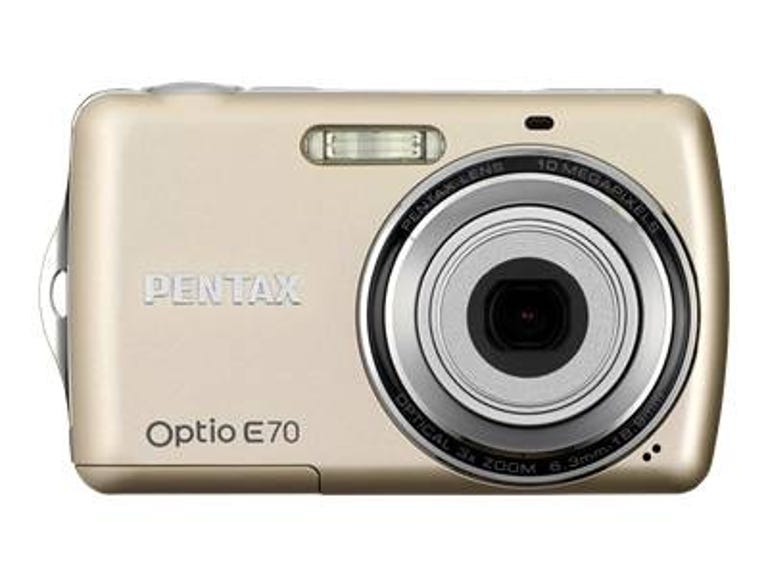The Pentax Optio E70 is an inexpensive ultracompact camera that takes good photos for the required investment in time and money. It's a nice-looking camera, too, with big controls well suited for beginners. Of course, you don't get much more than the basics at its price point and it certainly can't take on models priced a little higher in photo quality and especially not performance. But it would be tough to find something better with the E70's price, features, and size combination.
The Good
The Bad
The Bottom Line
| Key specs | Pentax Optio E70 |
| Price (MSRP) | $139.95 |
| Dimensions | 3.8 inches wide by 2.4 inches high by 0.9 inch deep |
| Weight (with battery and media) | 5.6 ounces |
| Megapixels, image sensor size, type | 10 megapixels, 1/2.33-inch CCD |
| LCD size, resolution | 2.4-inch LCD, 112K dots |
| Lens (zoom, aperture, focal length) | 3X, f3.1-5.9, 35-105mm (35mm equivalent) |
| File format (still/video) | JPEG/Motion JPEG |
| Highest resolution size (still/video) | 3,648x2,736 pixels (4:3)/ 640x480 at 30fps (16:9) |
| Image stabilization type | Electronic (auto, two types) |
| Battery type, rated life | 2 AA (alkaline, Li-ion, NiMH), 620 shots (Li-ion) |
The E70 is just small enough to be considered an ultracompact and is slight enough and light enough to stick in a pants pocket or small handbag--a rarity at its price. It's available in three colors, too: gold, blue, and red. Its design strength lies in its simplicity, though some may see this as just a lack of features. On top is a power button and shutter release with the rest of the controls (zoom rocker included) on the back.
If you really don't like small or cramped buttons, you'll probably love the E70. Buttons for menu navigation, flash, capture mode, drive mode, focus, playback, and even activating face detection are big and spaciously laid out and labeled with a large icon or word. This would be a front-runner for someone who has trouble seeing or using the smaller controls of other compact cameras. Pentax used a relatively small 2.4-inch LCD on the E70, though.
| General shooting options | Pentax Optio E70 |
| ISO sensitivity (full resolution) | Auto, 100, 200, 400, 800 |
| White balance | Auto |
| Recording modes | Auto Picture, Program, Scene, Movie |
| Focus | 9-point AF, Spot AF, Auto-tracking AF |
| Metering | Multi-segment, Center-weighted, Spot |
Not surprisingly, there isn't a lot of shooting flexibility with the E70. The Mode button opens up a menu of 18 shooting modes, including Pentax's auto-scene-selection option called Auto Picture, which determines the best shooting mode for your subject such as Landscape, Night Scene, or Flower. The results are reliable, so those who like to leave it in auto should be happy with the outcome. There's also a Program mode, which lets you pick focus area and ISO sensitivity, and adjust exposure compensation, and Pentax's anti-Program setting, Green mode, which takes away all control.
One thing worth mentioning is Pentax's new Pixel Track SR for helping minimize the effects of motion blur. Turn it on and it will track motion blur at the pixel level, determining in real time the amount of blur. Once you've taken a shot, it filters the effect motion has on each pixel to sharpen them and remove blur (all of this takes a few seconds after the photo is captured). In my tests it worked better than the traditional method of electronic stabilization of boosting ISO and shutter speed, as Pixel Track doesn't introduce more noise. However, in some of my shots it sacrificed sharpness in order to remove a slight blur. So it's not perfect, but it would be worth turning on if camera shake is unavoidable.
The camera's overall performance is merely OK. In CNET Labs' tests, the E70 averaged a power-on-to-first-shot time of 2.4, which isn't actually too bad. However, the shutter lag was long under both bright and dim lighting, 0.6 second and 1.2 seconds, respectively. Shot-to-shot times averaged 3.3 seconds without flash and 4.2 seconds with. Finally, though there isn't a burst mode, just a continuous shooting option, it was able to eke out 0.6 frames per second.
For the money, the E70 produces good photos. The camera offers ISO sensitivity settings from 100 to 6,400; however, ISO 3,200 and 6,400 are fixed at a 5-megapixel resolution. The E70 is best at or below ISO 200, but photos at all sensitivities look softened from noise reduction. There are no white balance options and unfortunately everything we shot indoors under incandescent light looked too warm. (This is particularly disappointing because the auto white balance in last year's Optio E60 was really accurate.) However, outdoors colors looked bright and natural, and photos were reasonably sharp and detailed.
The Optio E70 can record VGA-quality (640x480) motion JPEG video. But the quality isn't good for the most part, and the optical zoom does not function while recording. It's sufficient for small Web videos, but little else.
Yes, you can spend a little more money and get more features and possibly better photo quality and performance than the Pentax Optio E70. But if all you need is a convenient, attractive, and simple ultracompact camera for taking snapshots, the E70 should suffice.
(Shorter bars indicate better performance)
| Time to first shot | Typical shot-to-shot time (flash) | Typical shot-to-shot time | Shutter lag (dim) | Shutter lag (typical) |
(Longer bars indicate better performance)
Find out more about how we test digital cameras.



